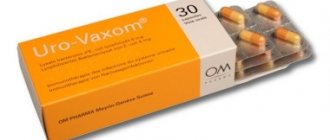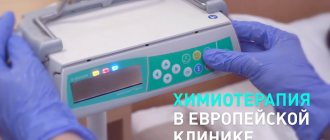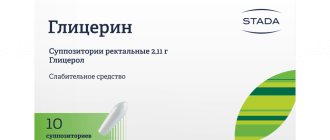Contraindications
Hypersensitivity, AV block, glaucoma, severe liver failure, old age (risk of developing hyperthermia), childhood.
Carefully
Conditions after traumatic brain injury, chronic renal failure, adrenal insufficiency, hypothyroidism, prostatic hyperplasia, supraventricular tachycardia, shock conditions.
Use during pregnancy and breastfeeding
The safety of the drug when used during pregnancy and breastfeeding has not been established. The use of the drug during pregnancy is justified only if the potential benefit to the mother outweighs the possible risk to the fetus. It is recommended to stop breastfeeding during treatment with the drug.
Papaverine
Dosage form:
rectal suppositories.
Composition per suppository:
Active substance
: papaverine hydrochloride – 20 mg; base for suppositories: solid fat (Vitepsol, Supposir) - until a suppository weighing 1.25 g is obtained.
Description:
suppositories from white to white with a yellowish or creamy tint, torpedo-shaped.
Pharmacotherapeutic group:
antispasmodic.
ATX code: A03AD01.
pharmachologic effect
Papaverine hydrochloride is a myotropic antispasmodic agent.
It is an inhibitor of the phosphodiesterase enzyme and causes intracellular accumulation of cyclic 3′,5′-adenosine monophosphate and a decrease in calcium content, which leads to impaired contractility of smooth muscles and their relaxation.
The effect of papaverine hydrochloride on the central nervous system is weak, only in large doses it has a sedative effect.
Reduces the tone of smooth muscles of internal organs (gastrointestinal tract, airways, genitourinary system) and blood vessels and therefore has a vasodilator and antispasmodic effect. In large doses, it reduces the excitability of the heart muscle and slows down intracardiac conduction.
Indications for use
Spasm of smooth muscles: abdominal organs (with cholecystitis, pylorospasm, spastic colitis, attacks of cholelithiasis), renal colic, spasm of the urinary tract; peripheral vessels (with endarteritis); cerebral vessels (for migraines); heart (for angina) – as part of complex therapy); bronchi (with bronchospasm).
Contraindications
Hypersensitivity to the components of the drug, atrioventricular (AV) blockade, glaucoma, severe renal failure, severe liver failure, old age (risk of developing hyperthermia), childhood.
Carefully
(in small doses) is used for conditions after traumatic brain injury, chronic renal failure, adrenal insufficiency, hypothyroidism, prostatic hyperplasia, supraventricular tachycardia, shock conditions.
Use during pregnancy and breastfeeding
During pregnancy and lactation, the drug should be used when the benefit to the mother outweighs the potential risk to the fetus or child. During treatment with the drug, breastfeeding is recommended to be suspended.
Directions for use and doses
Rectally. The suppository is inserted into the anus (after a cleansing enema or spontaneous bowel movement), having previously freed the suppository from the contour packaging using scissors (cutting the packaging along the contour of the suppository). Use 1-2 suppositories 2-3 times a day.
Side effect
Possible allergic reactions, partial or complete atrioventricular block, ventricular extrasystole, decreased blood pressure, increased activity of “liver” transaminases, hypotension, drowsiness, constipation, eosinophilia. Inform your doctor if you experience any unwanted or unpleasant reactions or sensations.
Overdose
Symptoms
: diplopia, weakness, decreased blood pressure, drowsiness. Treatment: symptomatic (maintaining blood pressure).
Interactions with drugs
Papaverine reduces the antiparkinsonian effect of levodopa and the hypotensive effect of methyldopa. In combination with barbiturates, the antispasmodic effect of papaverine is enhanced. When used together with tricyclic antidepressants, procainamide, reserpine, quinidine sulfate, the hypotensive effect may be enhanced.
special instructions
During treatment with the drug, ethanol intake should be avoided. The vasodilating effect is reduced by smoking.
Impact on the ability to drive vehicles and machinery
During treatment with the drug, you should refrain from driving vehicles and engaging in other potentially hazardous activities that require increased concentration and speed of psychomotor reactions.
Release form
Rectal suppositories 20 mg.
4, 5, 6 suppositories in a contour cell packaging made of a two-layer aluminum-polyethylene film or a film made of polymer materials or a white PVC/PE film combined or a polyvinyl chloride film.
1, 2 blister packs together with instructions for medical use of the drug are placed in a cardboard pack.
Storage conditions
In a place protected from moisture and light at a temperature not exceeding 25 ° C.
Keep out of the reach of children.
Best before date
2 years. Do not use after the expiration date stated on the label.
Vacation conditions
Available without a prescription.
PAPAVERINA HYDROCHLORIDE 20MG SUPPORTS No. 10
Instructions
Trade name of the drug: Papaverine® (Papaverinum)
Active ingredients: Papaverine hydrochloride*
Pharmacotherapeutic group: Antispasmodics, Antispasmodics.
Release form:
Rectal suppositories 20 mg. 5 suppositories each in a blister pack made of polyvinyl chloride film, two blister packs along with instructions for medical use of the drug in a cardboard box.
Dosage form:
Rectal suppositories 20 mg N10 (2×5) (blister packs)
Compound:
One suppository contains: papaverine hydrochloride - 20 mg, bases for suppositories: solid fat (vitepsol, supposir) - a sufficient amount to obtain a suppository weighing 1.25 g.
Pharmacological properties:
Papaverine hydrochloride is a myotropic antispasmodic agent. Inhibits phosphodiesterase, causes the accumulation of cyclic 3,5-AMP in the cell and a decrease in calcium levels. Relaxes the smooth muscles of internal organs (gastrointestinal tract, airways, genitourinary system) and blood vessels. In large doses, it reduces the excitability of the heart muscle and slows down intracardiac conduction.
Indications for use:
Spasm of smooth muscles: abdominal organs (with cholecystitis, pylorospasm, spastic colitis, renal colic); peripheral vessels (with endarteritis); cerebral vessels (for migraines); heart (for angina pectoris - as part of complex therapy); bronchi (with bronchospasm).
Mode of application:
Having freed the suppository from the contour packaging, it is inserted into the anus. Use 1 suppository 2-3 times a day after spontaneous bowel movement or cleansing enema.
Side effects:
Possible allergic reactions, atrioventricular block, ventricular extrasystole, increased activity of “liver” transaminases, hypotension, drowsiness, constipation, eosinophilia.
Contraindications:
Hypersensitivity to the components of the drug, atrioventricular block, glaucoma, severe liver failure, old age (risk of developing hyperthermia), children (up to 6 months).
Drug interactions:
Papaverine reduces the antiparkinsonian effect of levodopa and the hypotensive effect of methyldopa. In combination with barbiturates, the antispasmodic effect of papaverine is enhanced. When used together with tricyclic antidepressants, procainamide, reserpine, quinidine sulfate, the hypotensive effect may be enhanced.
Special instructions:
During treatment with the drug, ethanol intake should be avoided. During pregnancy and lactation, the safety of the drug has not been established. The vasodilating effect is reduced by smoking. Use with caution (in small doses) in conditions after traumatic brain injury, chronic renal failure, adrenal insufficiency, hypothyroidism, prostatic hyperplasia, supraventricular tachycardia, shock conditions.
Overdose:
Symptoms: diplopia, weakness, decreased blood pressure, drowsiness. Treatment: symptomatic (maintaining blood pressure).
Storage conditions:
In a dry place, protected from light at a temperature above 25°C. Keep out of the reach of children.
Best before date:
2 years. Do not use the drug after the expiration date indicated on the package.
Vacation conditions:
Over the counter.
Papaverine rectal suppositories 20 mg No. 5x2
Name
Papaverine supp rect. 20 mg in container pack No. 5x2
Description
Suppositories are cylindrical-conical, white or white with a yellowish tint. The cut is allowed to have an airy, porous rod and a funnel-shaped recess
Main active ingredient
Papaverine hydrochloride
Release form
Rectal suppositories
Dosage
20mg
pharmachologic effect
Drugs for the treatment of functional disorders of the gastrointestinal tract. Papaverine and its derivatives. ATX code: A03A D01.
Pharmacodynamics
Papaverine hydrochloride reduces smooth muscle tone and therefore has a vasodilator and antispasmodic effect. The effect of papaverine hydrochloride on the central nervous system is weak, only in large doses, it has some sedative effect. In large doses, it reduces the excitability of the heart muscle and slows down intracardiac conduction. Mechanism of action. It is an inhibitor of the phosphodiesterase enzyme and causes intracellular accumulation of cyclic 3,5-adenosine monophosphate, which leads to impaired contractility of smooth muscles and their relaxation during spastic conditions.
Pharmacokinetics
Absorption of papaverine depends on the dosage form. Bioavailability on average is 54%. Communication with blood plasma proteins - 90%. It is well distributed and penetrates histohematic barriers. Metabolized in the liver. The half-life (T?) is 0.5-2 hours (can be extended to 24 hours). Excreted by the kidneys in the form of metabolites. It is completely removed from the blood during hemodialysis.
Indications for use
Spasm of smooth muscles of the abdominal organs (cholecystitis, pylorospasm, spastic colitis, renal colic).
Directions for use and doses
The use of this medicine is possible only after consultation with a doctor! Rectally. The suppository is inserted into the anus (after a cleansing enema or spontaneous bowel movement), having previously freed the suppository from the contour packaging using scissors (cutting the packaging along the contour of the suppository). Use 1-2 suppositories 2-3 times a day. Instructions for rectal administration of the drug When using rectal suppositories, abdominal cramps and the urge to defecate often occur, so before the procedure, perform a cleansing enema or empty your bowels naturally. Wash your hands thoroughly with soap. Prepare wet wipes or a handkerchief soaked in water in advance. Lie on your side with your knees close to your stomach. This position is the most comfortable for the procedure, as it allows you to minimize discomfort. Remove the candle from the contour packaging using scissors (cutting the packaging along the contour of the candle). The candle is taken with the thumb and middle finger of the right hand in the middle of the widest part, the index finger rests on the blunt end of the candle. The candle is directed with the free end towards the anus and pushed with the index finger into the anal canal until it is completely immersed to a depth of 2-3 cm. Carry out the procedure carefully, without applying unnecessary pressure. Despite the fact that the suppository has a streamlined shape, careless use can injure the mucous membrane. Stay in bed for about 20 minutes. Wipe your hands with a previously prepared wet napkin or handkerchief. If the urge to defecate occurs within 10 minutes after inserting the rectal suppository, empty your bowels and insert a new suppository. If more than 10 minutes have passed between the administration of the suppository and bowel movement, an additional dose of medication is not required.
Use during pregnancy and lactation
If you are pregnant or breastfeeding, think you may be pregnant, or think you might be pregnant, tell your doctor. During pregnancy and lactation, the safety of the drug has not been established, so use with caution.
Precautionary measures
The drug should be prescribed with caution and in small doses to elderly and debilitated patients, as well as patients with traumatic brain injury, impaired liver or kidney function, hypothyroidism, adrenal insufficiency, prostatic hyperplasia, as well as patients with supraventricular tachycardia and those in shock. . During the treatment period, alcohol consumption should be avoided. Smoking reduces the vasodilating effect of papaverine. Pregnancy and lactation Caution should be exercised during pregnancy and lactation. Effect on the ability to drive vehicles and operate potentially dangerous mechanisms When taken in therapeutic doses, the drug does not affect the ability to drive a car or other potentially dangerous mechanisms.
Interaction with other drugs
If you are currently or have recently taken other medications, tell your doctor. Not prescribed together with β-adrenergic drugs (causes a risk of arrhythmias). Papaverine may enhance the hypotensive effect of antihypertensive drugs. The effects of papaverine are potentiated by anesthetic, analgesic, sedative and tranquilizing substances. When used together with tricyclic antidepressants, procainamide, reserpine, quinidine, the hypotensive effect of papaverine may be enhanced. Papaverine reduces the effects of dopegit and levodopa. Nicotine (smoking) reduces the effectiveness of papaverine. The antispasmodic effect of papaverine is enhanced by diphenhydramine (diphenhydramine), metamizole (analgin), and diclofenac. When used simultaneously with cardiac glycosides, a pronounced increase in myocardial contractile function is observed due to a decrease in total peripheral vascular resistance. When used with procainamide, the hypotensive effect may be enhanced. There is evidence of the development of hepatitis when used together with furadonin. Papaverine hydrochloride potentiates the effect of alcohol. Pharmaceutically compatible with dibazole.
Contraindications
Hypersensitivity to the components of the drug, inflammatory processes of the rectum, coma, respiratory depression, broncho-obstructive syndrome, AV conduction disorders, atrioventricular block, glaucoma, severe liver failure, old age (risk of developing hyperthermia), children's age (up to 18 years).
Compound
1 suppository contains: active substance: papaverine hydrochloride 20 mg, excipients: semi-synthetic glycerides (suppocir AM (solid fat)).
Overdose
Symptoms: blurred vision, diplopia, weakness, dry mouth, redness of the skin of the upper body, hyperventilation, nystagmus, ataxia, tachycardia, asystole, ventricular flutter, collapse, arterial hypotension, drowsiness, headache, nausea, constipation, increased sweating, allergic reactions. If you accidentally take very large doses of papaverine, a toxic effect of the drug in the form of arrhythmias, complete or partial atrioventricular block is possible. Treatment: drug withdrawal, symptomatic therapy. There is no specific antidote. It is completely removed from the blood during hemodialysis.
Side effect
From the skin and subcutaneous tissue: allergic reactions, skin hyperemia, urticaria, itching, skin rashes, reactions at the injection site. From the hematopoietic system: eosinophilia. From the cardiovascular system: blockade, arrhythmia, ventricular fibrillation, ventricular extrasystole, tachycardia, asystole, ventricular flutter, collapse, arterial hypotension. From the nervous system: drowsiness, weakness, headache, dizziness, apnea. From the side of the organ of vision: visual impairment (diplopia). From the gastrointestinal tract: increased activity of liver transaminases, nausea, diarrhea, constipation, anorexia, dry mouth. Other: increased sweating. If side effects occur, tell your doctor. This applies to all possible side effects, including those not described in this leaflet.
Storage conditions
Store in a dry place, protected from light, at a temperature of 15 °C to 25 °C. Keep out of the reach of children!


